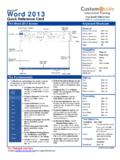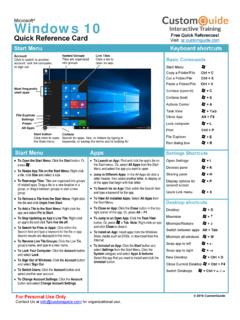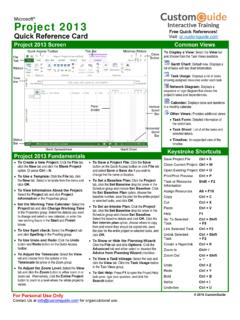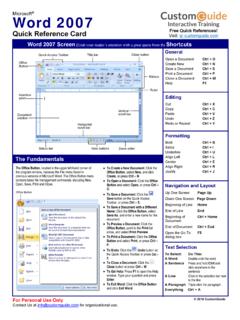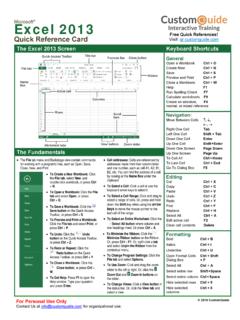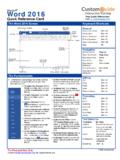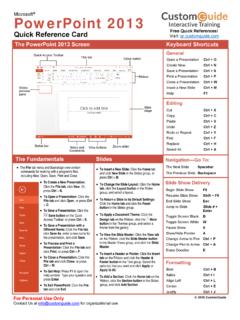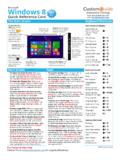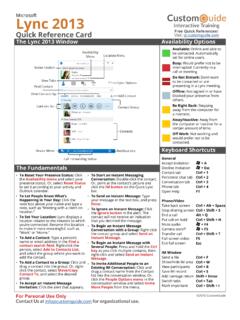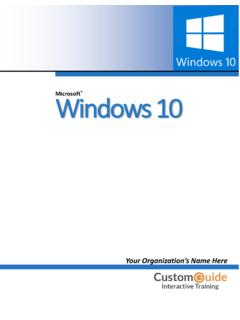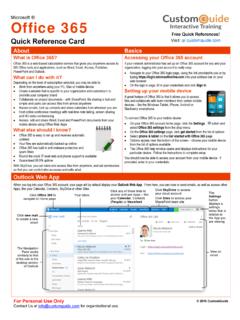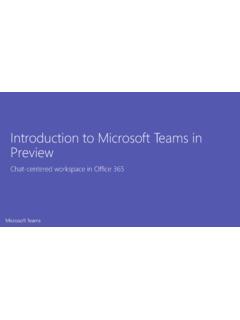Transcription of Office 2010 Quick Reference - Microsoft Office …
1 The Ribbon Microsoft Office 2010 Quick Reference Card The File tab replaces the File menu and Office Button found in previous versions of Microsoft Office . Common file management commands Save, Save As, Open, and Close appear at the top of the menu. Ribbon: Displays the commands and tools you need to perform varioustasks. The ribbon can also be minimized and customized to fit your workstyle. Tabs: Display the commands you can use in a Microsoft Office a tab to view its commands. Contextual tabs: Display commands for a selected object. Dialog Box Launcher: Click to open a dialog box or task pane. Group: Related commands that appear under each tab.
2 Gallery: A list of options and additional choices displayed as thumbnailpreviews so you can see results before making a choice. Quick Access Toolbar: Provides Quick access to the commands you usemost frequently. The Save, Undo, and Redo/Repeat buttons appear on theQuick Access Toolbar by default. To Minimize the Ribbon: Click the Minimize Ribbon button on the , press <Ctrl> + <F1>. Or, double-click a tab on the Ribbon. Or, right-clicka tab and select Minimize Ribbon from the contextual menu. To Customize the Ribbon: Right-click a tab and select Customize theRibbon from the contextual menu. Or, click the File tab, select Options, and click Customize Ribbon.
3 Use the controls in the dialog box to rename andrearrange tabs, and to rearrange tab commands.* Click the New Tab button to create a new tab on the Ribbon.* Click the New Group button to create a new group in a tab on the Ribbon. To Add a Command to the Quick Access Toolbar: Click the CustomizeQuick Access Toolbar button and select a command from the menu. ClickMore Commands to select from a longer list of commands. Get Help: Click the Help button. Or, press <F1>. Or, click the File tab andselect Help from the menu. Info: Set permissions to control who can open orchange the document; prepare the file for sharing byremoving metadata and other personal information;and view and manage autosaved versions of thedocument.
4 Recent: Displays documents most recently opened inthe program. New: Create a new blank document, or create adocument from a template. Browse templates with thepreview feature in Backstage view. Print: Preview the document and set print settings atthe same time. The right pane displays a preview ofthe file; the center pane displays print options. Save & Send: Share the file, and change file are four ways to share a Using E-mail: Send the document as anattachment, a link, a PDF or XPS, or to Web: Save to a SkyDrive folder throughyour Windows Live to SharePoint: Saves to a list or library ona SharePoint : Publish the document to a service orblog. Help: Learn more about a task or the view appears when you click the File tab.
5 The left panel displays commands in the File tab menu. The center panel displays options related to the selected command. The right panel displays a preview or additional options for a command. File Tab and Backstage View Backstage View Commands Dialog Box Launcher Help Tabs GroupGallery Minimize Ribbon Contextual tab Quick Access Toolbar Free Quick References!Visit: 2016 CustomGuide For Personal Use Only Contact Us at for organizational use. Insert Screenshots A Screenshot is an image of any visible item displayed on your monitor, such as a program window. To Insert a Screenshot: Click the Insert tab on the Ribbon and click the Screenshot button in the Illustrations group (Word/Excel/Outlook) or the Images group (PowerPoint), then click an available window.
6 To Insert a Screen Clipping: Click the Insert tab on the Ribbon and click the Screenshot button in the Illustrations group (Word/Excel/Outlook) or the Images group (PowerPoint), then click Screen Clipping. Click and drag your mouse across the area of the program window that you want to clip. Picture Tools Microsoft Office 2010 suite offers enhanced tools for editing and adjusting pictures. To Remove Backgrounds: Click the Format tab on the Ribbon and click the Remove Background button in the Adjust group. Refine the image and click Keep Changes. To Correct Brightness and Contrast or to Sharpen or Soften a Picture: Click the Format tab on the Ribbon, click the Corrections button in the Adjust group, and select an option from the gallery.
7 To Change the Color of a Picture: Click the Format tab on the Ribbon, click the Color button in the Adjust group, and select an option from the gallery. To Apply an Artistic Effect: Click the Format tab on the Ribbon, click the Artistic Effects button in the Adjust group, and select an option from the gallery. SmartArt SmartArt has a few improvements in Office 2010 , offering a new picture category for SmartArt graphics. To Insert Picture SmartArt: Click the SmartArt button on the Insert tab of the Ribbon and click Picture in the Choose a SmartArt graphic dialog box. Select the picture SmartArt graphic you wish to use and click OK. To Add a Picture to a SmartArt Graphic: Click the picture icon in the SmartArt graphic, find and select a picture, and click OK.
8 Paste with Live Preview WordArt WordArt has received a huge facelift in Office 2010 . New WordArt styles and functionality make it easy to add and format WordArt. It is also treated as text instead of a picture, so the text is searchable in the document. To Add WordArt: Click the Insert tab on the Ribbon and click the WordArt button in the Text group. Click the WordArt style from the gallery and enter the text in the text box. To Move WordArt: Click the WordArt object, drag it to the desired location, and release the mouse button. To Format WordArt: Click the WordArt object, then click the Format tab on the Ribbon under drawing tools. Select a formatting option in the WordArt Styles group, or click a new Word Art style from the gallery.
9 File Management Tools The Microsoft Office 2010 suite offers new and improved tools to help you manage, protect, and share your content. Autosaved Versions: This feature improves on the AutoRecover feature from earlier versions of Office . The AutoRecover feature automatically saves versions of your files at regular intervals to protect them if a program fails. Now, you can access those versions whenever you want. This makes it easy to revert to an earlier version of the file, or to recover changes when you forget to save manually. To Recover Autosaved Versions: Click the File tab on the Ribbon and select Info. Select an autosaved version from the Versions list.
10 Or, click the Manage Versions button and select Recover Draft Versions. Protected view: The purpose of Protected View is to protect you from cyber-attacks. When a file appears to be from a risky location, such as the Internet, it is opened in Protected View, which is a read-only mode. If you trust the file, you can then enable editing and work with the file as usual. Trusted documents: Trusted documents now remembers the trust decisions you make in a document so you don t have to be asked if a document with active content ( Macros, ActiveX controls, etc.) is safe every time you open it. Accessibility Checker: Helps you identify and resolve problems in your files that might keep someone with a disability from accessing your content.
